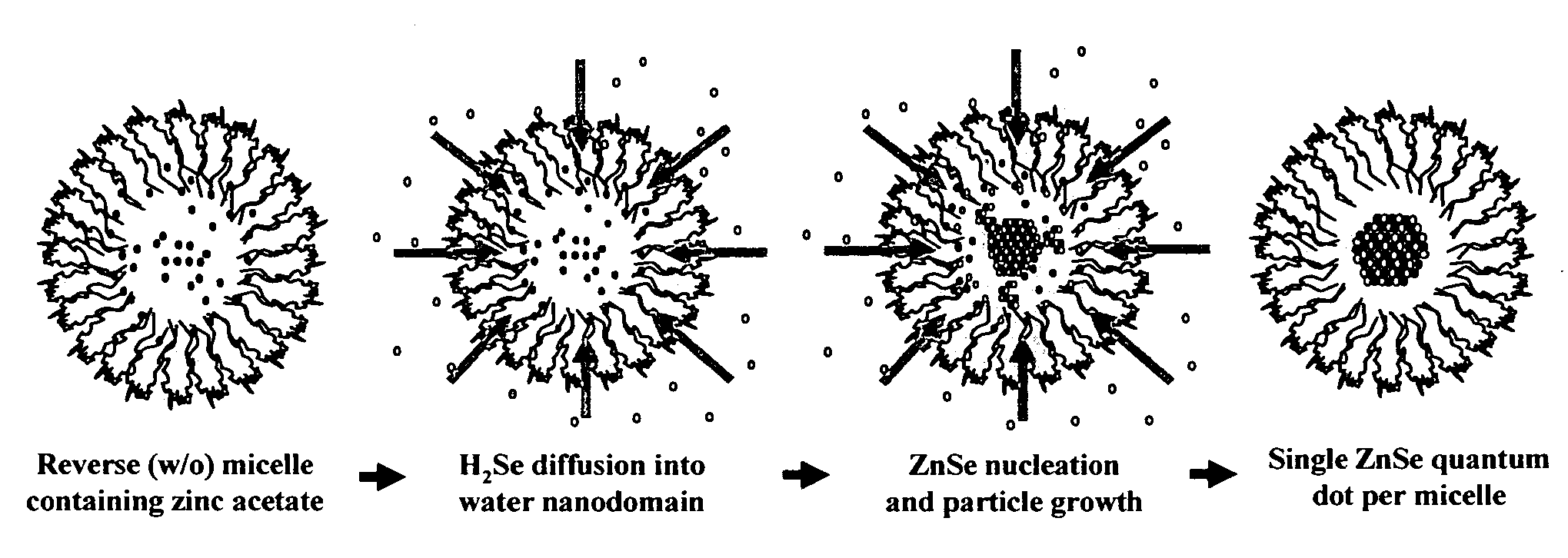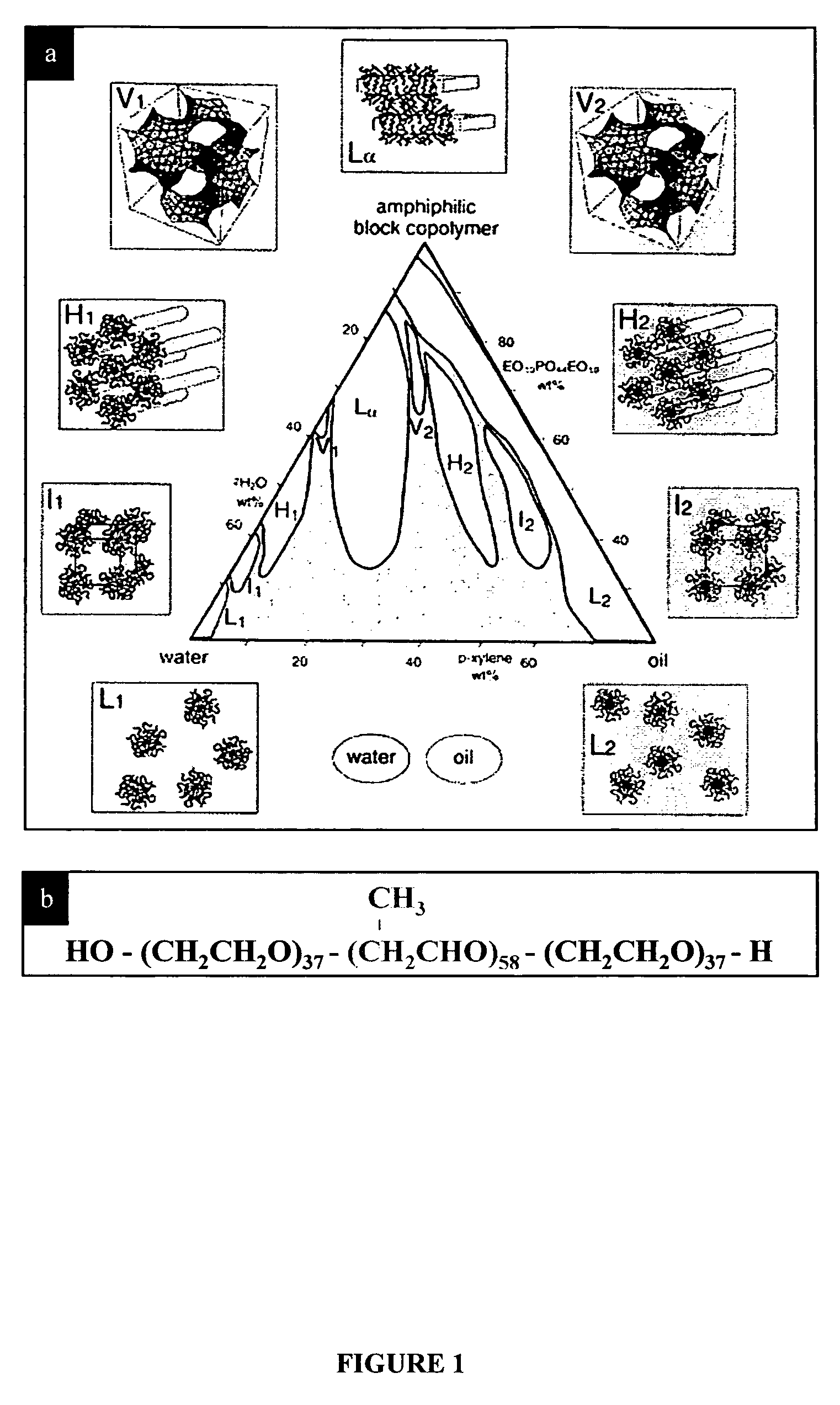Synthesis of nanostructured materials using liquid crystalline templates
a nanostructured material and template technology, applied in nanoinformatics, mercury compounds, tin oxides, etc., can solve the problems of difficult to isolate particles with a specific, pre-determined particle size, and difficulty in precisely controlling particle size distribution in such reactors
- Summary
- Abstract
- Description
- Claims
- Application Information
AI Technical Summary
Problems solved by technology
Method used
Image
Examples
example 1
Formation of Liquid Crystalline Templates Using Water and p-Xylene
[0084]The liquid crystalline templates were prepared at room temperature by mixing specific amounts of PEO-PPO-PEO block copolymer with p-xylene (P-C8H10) as the less polar phase and a 1 M solution of zinc acetate dihydrate (Zn(C2H3O2)2.2H2O) in water (H2O) as the polar phase, in screw cap glass vials. PPO is the p-xylene-soluble block and PEO is the water-soluble block. The amount of each component in the mixture depends on the type of the liquid crystalline phase of interest. For example, a mixture composed of 58 wt % PEO-PPO-PEO, 32 wt % p-xylene, and 10 wt % of 1 M zinc acetate dihydrate in water yields a reverse (water-in-xylene) cubic liquid crystalline phase, whereas a mixture composed of 31 wt % PEO-PPO-PEO, 2 wt % p-xylene, and 67 wt % of 1 M zinc acetate dihydrate in water yields a normal (xylene-in-water) cubic liquid crystalline phase. The former mixture will yield solid nanostructures, i.e., quantum dots,...
example 2
Templated Synthesis of ZnSe Nanostructures
[0089]A septum vial containing a PEO-PPO-PEO / water / p-xylene liquid crystalline template, which was made according to the protocol above, was placed inside a reactor. The reactor was a tubular stainless steel chamber with a diameter of 1 inch that was used to accommodate the vial containing the template. The air was removed from the system by a pulling vacuum for 15 min. and a subsequent 20 min. flow of N2 into the system. The reactor was equipped with an inner tube with a diameter of ¼ inch that was used for the transfer of gas. Under 1 atm of N2, the reactor inner tube was inserted into the vial through the septum, which allowed contact between the liquid crystal and the surrounding gas. The N2 was subsequently removed by evacuation, and the reactor was immediately backfilled with a 5% H2Se in H2 gas mixture, at room temperature, until a pressure of 1 atm. was obtained. A 6-hour contact between H2Se and the Zn-doped liquid crystal was found...
example 3
Properties of ZnSe Quantum Dots
[0093]ZnSe synthesized particles are crystalline in nature, as revealed by high resolution TEM (“HR-TEM”) (FIG. 4), and have an average diameter of 3 nm. The quantum dots in FIG. 4 were grown using a liquid crystalline template with composition 55 wt % PEO-PPO-PEO, 23 wt % p-xylene, and 22 wt % of 1 M zinc acetate dihydrate in water. Using this liquid template, formed according to the methods set forth in Example 1, the production of the nanostructures was completed as described above. In order for the TEM analysis to be carried out, the liquid crystalline template containing the nanocrystals was dispersed in ethanol, a few drops of the dispersion were placed on a TEM grid, and the solvents were evaporated in a fume hood.
[0094]Room-temperature photoluminescence spectra of synthesized ZnSe quantum dots are shown in FIG. 5. Spectrum (1) corresponds to a template composition of 50 wt % PEO-PPO-PEO, 33 wt % p-xylene, and 17 wt % of 1 M zinc acetate dihydra...
PUM
| Property | Measurement | Unit |
|---|---|---|
| pressure | aaaaa | aaaaa |
| thickness | aaaaa | aaaaa |
| diameter | aaaaa | aaaaa |
Abstract
Description
Claims
Application Information
 Login to View More
Login to View More - R&D
- Intellectual Property
- Life Sciences
- Materials
- Tech Scout
- Unparalleled Data Quality
- Higher Quality Content
- 60% Fewer Hallucinations
Browse by: Latest US Patents, China's latest patents, Technical Efficacy Thesaurus, Application Domain, Technology Topic, Popular Technical Reports.
© 2025 PatSnap. All rights reserved.Legal|Privacy policy|Modern Slavery Act Transparency Statement|Sitemap|About US| Contact US: help@patsnap.com



